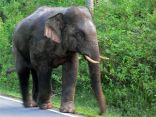- Marsupials (Diprotodontia)
- Carnivorous marsupials (Dasyuromorphia)
- Tenrec (Afrosoricida)
- Elephant shrew (Macroscelidea)
- Elephant (Proboscidea)
- Sea cows (Sirenia)
- Armadillos (Cingulata)
- Edentata (Pilosa)
- Treeshrew (Scandentia)
- Primate (Primates)
- Rodent (Rodentia)
- Bats (Chiroptera)
- Even-toed ungulate (Artiodactyla)
- Odd-toed ungulate (Perissodactyla)
- Carnivores (Carnivora)
Elephant (Proboscidea)
The Proboscidea (from Latin proboscis, from Ancient Greek προβοσκίς (proboskís) 'elephant's trunk') are a taxonomic order of afrotherian mammals containing one living family (Elephantidae) and several extinct families. First described by J. Illiger in 1811, it encompasses the elephants and their close relatives. From the mid-Miocene onwards, most proboscideans were very large. The largest land mammal of all time may have been a proboscidean; Palaeoloxodon namadicus was up to 5.2 m (17.1 ft) at the shoulder and may have weighed up to 22 t (24.3 short tons), almost double the weight of some sauropods like Diplodocus carnegii. The largest extant proboscidean is the African bush elephant, with a record of size of 4 m (13.1 ft) at the shoulder and 10.4 t (11.5 short tons). In addition to their enormous size, later proboscideans are distinguished by tusks and long, muscular trunks, which were less developed or absent in early proboscideans. Three species of elephant are currently recognised: the African bush elephant, the African forest elephant, and the Asian elephant. Elephantidae is the only surviving family of the order Proboscidea; extinct members include the mastodons, gomphotheres and stegodonts. The family Elephantidae also contains several extinct groups, including the mammoths and straight-tusked elephants. The distinctive features of proboscideans include a trunk, tusks, and massive legs. Large ear flaps are present in some proboscideans, including elephants. Some also have tough but sensitive skin; others, like the woolly mammoth, have a coat. The trunk is used for breathing, bringing food and water to the mouth, and grasping objects. Tusks, which are derived from the incisor teeth, serve both as weapons and as tools for moving objects and digging. The large ear flaps assist in maintaining a constant body temperature as well as in communication. The pillar-like legs carry their great weight.
woaqzo@yahoo.com
